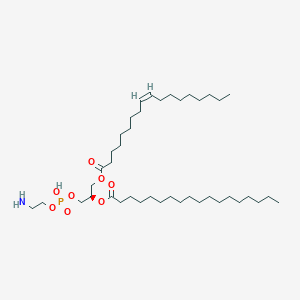| General Information of MET (ID: META00576) |
| Name |
PE(18:1(9Z)/18:0)
|
| Synonyms |
Click to Show/Hide Synonyms of This Metabolite
1-(9Z-Octadecenoyl)-2-octadecanoyl-sn-glycero-3-phosphoethanolamine; 1-Oleoyl-2-stearoyl-sn-glycero-3-phosphoethanolamine; GPEtn(18:1/18:0); GPEtn(36:1); PE (18:1N-9/18:0); PE(18:1(9Z)/18:0); PE(18:1/18:0); PE(36:1); Phophatidylethanolamine(18:1/18:0); Phophatidylethanolamine(36:1)
|
| Source |
Endogenous;Escherichia Coli Metabolite;Glycerophospholipids;Food;Microbial
|
| Structure Type |
Glycerophosphoethanolamines (Click to Show/Hide the Complete Structure Type Hierarchy)
Lipids and lipid-like molecules
Glycerophospholipids
Glycerophosphoethanolamines
|
| PubChem CID |
|
| HMDB ID |
|
| Formula |
C41H80NO8P
|
| Structure |
<iframe style="width: 300px; height: 300px;" frameborder="0" src="https://embed.molview.org/v1/?mode=balls&cid=9546755"></iframe>
|
 |
|
3D MOL is unavailable
|
2D MOL
|
|
Click to Show/Hide the Molecular/Functional Data (External Links/Property/Function) of This Metabolite
|
| ChEBI ID |
|
| FooDB ID |
|
| Physicochemical Properties |
Molecular Weight |
746 |
Topological Polar Surface Area |
134 |
| XlogP |
11.5 |
Complexity |
856 |
| Heavy Atom Count |
51 |
Rotatable Bond Count |
42 |
| Hydrogen Bond Donor Count |
2 |
Hydrogen Bond Acceptor Count |
9 |
| Function |
PE(18:1(9Z)/18:0) is a phosphatidylethanolamine (PE or GPEtn). It is a glycerophospholipid in which a phosphorylethanolamine moiety occupies a glycerol substitution site. As is the case with diacylglycerols, glycerophosphoethanolamines can have many different combinations of fatty acids of varying lengths and saturation attached at the C-1 and C-2 positions. Fatty acids containing 16, 18 and 20 carbons are the most common. PE(18:1(9Z)/18:0), in particular, consists of one chain of oleic acid at the C-1 position and one chain of stearic acid at the C-2 position. The oleic acid moiety is derived from vegetable oils, especially olive and canola oil, while the stearic acid moiety is derived from animal fats, coco butter and sesame oil. Phospholipids, are ubiquitous in nature and are key components of the lipid bilayer of cells, as well as being involved in metabolism and signaling.While most phospholipids have a saturated fatty acid on C-1 and an unsaturated fatty acid on C-2 of the glycerol backbone, the fatty acid distribution at the C-1 and C-2 positions of glycerol within phospholipids is continually in flux, owing to phospholipid degradation and the continuous phospholipid remodeling that occurs while these molecules are in membranes. PEs are neutral zwitterions at physiological pH. They mostly have palmitic or stearic acid on carbon 1 and a long chain unsaturated fatty acid (e.g. 18:2, 20:4 and 22:6) on carbon 2. PE synthesis can occur via two pathways. The first requires that ethanolamine be activated by phosphorylation and then coupled to CDP. The ethanolamine is then transferred from CDP-ethanolamine to phosphatidic acid to yield PE. The second involves the decarboxylation of PS.
|
|
Regulatory Network
|
|
|
|
|
|
|
|
|
 click to show the details of this protein
click to show the details of this protein
 click to show the details of experiment for validating this pair
click to show the details of experiment for validating this pair

